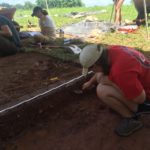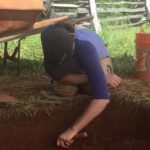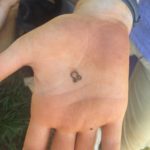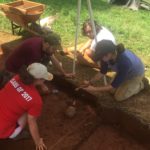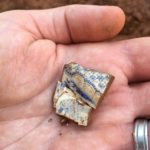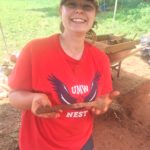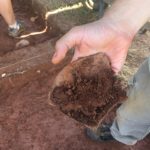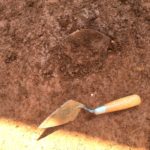Archaeology Blog
Field School Week 6
By Ryan McDowell
Six weeks, gone by in a blink of an eye, but time is strange like that. Logically, standing outside in the hot sun all day, digging up thick red clay, or bent over screening it should be a grueling task that does not go by quickly, but when you surrounded by wonderful people and beautiful scenery it does. During our final week of field school, we continued to work at our units located close to the Northwest area of the curtilage. For the first couple of days only small amounts of artifacts were found ranging from ceramic sherds, glass pieces, and iron nails. On Tuesday, this changed when an unusual cluster of rock cobbles were uncovered at the base of the more southern unit. In order to better understand what this could possibly be we began excavating a new unit located directly between the two that we were working on. Thursday turned into an exciting day as many exciting artifacts were found. These diverse items included unique items like a metal handle, a metal base, and a button. The quantity of items continued through Friday from both units being excavated with many whole nails, sherds of unique ceramics, and a clothing clasp unearthed. The finding of so many tantalizing objects made it all the more difficult to see the field school end.
For the final week, we all chose a project to work on related to Site 33, where we have been working this summer. The topics for this project varied greatly. Logan’s project was to conduct a minimum vessel count for the ceramic sherds we had found this summer. A minimum vessel count is a tool used by archaeologists to group sherds of ceramic together that came from the same vessel. This is extremely helpful for archaeologists since it gives a more accurate representation of how many ceramic vessels are actually present. After Logan completed her minimum vessel count, she compared hers to one already completed for previous work at Site 33. Les’ project looked at the context of fencing at Poplar Forest in an attempt to explain the abundance of barbed wire being discovered. He analyzed many historical photos and videos in an attempt to relocate lost fence lines and then endeavored to relocate the fences by looking for physical evidence across the property. His project showed the importance of the fence lines by what they told us about the use of the land. For my project, I first analyzed the keys we found this summer then compared them to ones found elsewhere at Poplar Forest. I made comparisons of key material, quantity from sites related to the main house or enslaved individuals, and quantity of keys from all the enslaved sites. I hoped to convey the notion of privacy for enslaved individuals and present the question of how enslaved individuals interact with one another. Every project showcased just a few of the different ways Site 33 could be interpreted. We closed field school by discussing all the things we had learned this summer and ways we believe archaeology could continue at Poplar Forest.
As our summer at Poplar Forest ends, it is clear that the marks we leave behind is more than just filled in excavation units. Through our work and the countless others both before and after there is a better understanding of the full scope of Thomas Jefferson’s Poplar Forest.
